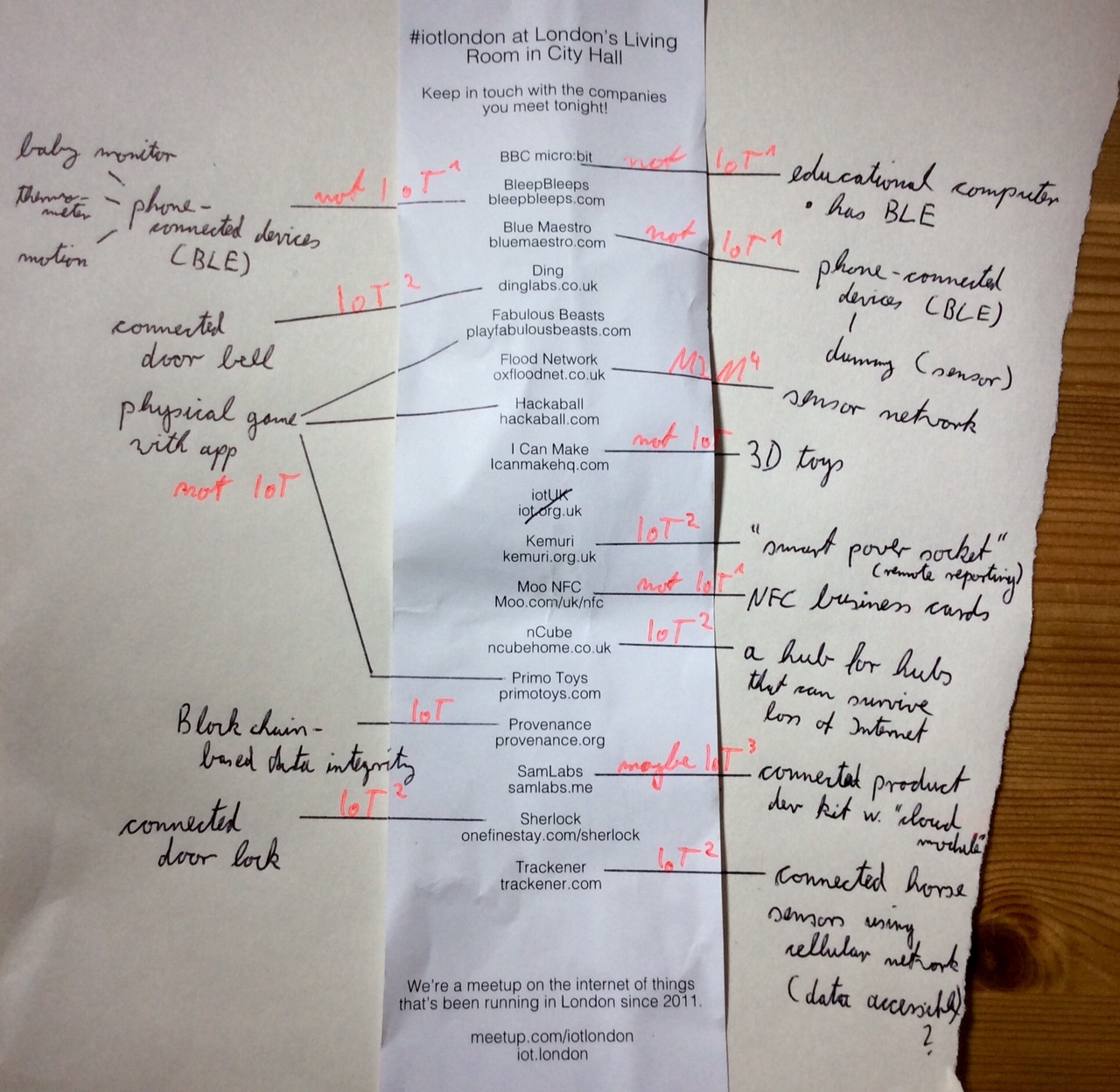Where are the consumer IoT products?
Last Tuesday saw another special event as part of the IoT London Meetup series, when our host and organiser Alex Deschamps-Sonsino invited us to the City Hall.
Our poshest host yet! #iotlondon pic.twitter.com/Y3vrRVwzuW
— London IOT Meetup (@iotlondon) October 20, 2015The focus of this meeting was a showcase of local IoT innovation, and with London being one of the hotbeds for the Internet of Things in Europe (if not in the world), I had great expectations. The event had been paraphrased The (Connected) Living Room because of the name of the venue (aka London’s Living Room at City Hall), and somehow I had envisioned creative, innovative and compelling examples of consumer products for our connected future.
Unfortunately, my main comment remained: This is not the Internet of Things.
FYI #IoT pic.twitter.com/Ll6iJyXXIV
— Kevin Ashton (@Kevin_Ashton) September 19, 2015
Both Alex and I have voiced our opinions about what an IoT product constitutes,
@iotwatch Your overview inspired me to this table that I frequently use to explain why software dev for IoT is hard. pic.twitter.com/7zNA2t67UG
— Boris Adryan (@BorisAdryan) August 24, 2015and simply putting a chip in it doesn’t quite cut the mustard for qualifying as intelligent consumer IoT.
The list of exhibitors and their products shocked me. There were no ‘new kids on the block’, no ‘unexpected surprises’, and many of those who exhibited weren’t even IoT. Now, I don’t blame Alex and I’m aware she’s working very hard behind the scenes to make events like this happen. But there seems to be a blatant lack of novelty in the field and I wonder why that is. I feel like I’m heading straight into the trough of disillusionment.

Don’t get me wrong, these are all very fine products and even though I classify many of them as “not IoT”, I do own and love them. However, I’m still totally underwhelmed about the lack of true novelty and inspiration and appropriate utilisation of Internet-connectivity I expected from our local community.
Footnotes for the picture:
- Most products in this category connect via Bluetooth Low Energy (BLE) to a specific phone app. I grant the inventors, designers and engineers that -in theory- from there you can transmit to anywhere in the world. But with the exception of the BlueMaestro Tempo Anywhere that can serve as a hub device, none of these products are truly internet-integrated without the phone. In a way, BlueMaestro’s Pacif-i and BleepBleeps’ Tony Tempa are smart products, but no more IoT than the Philips Shaver in Kevin Ashton’s tweet. Still, I recommend everyone to have a look at these products. They’re lovely.
- I’d give these products the IoT badge, although with the exception of a vague mention on the Internet that Trackener provides an API endpoint, none of them get a gold star for the lack of openness. (But I stand corrected if I didn’t research correctly here.)
- The SamLabs electronics kits give you all the tools you’d need to create an Internet-connected device. The more expensive hardware packs seem based around a ‘cloud module’ which suggests true IoT potential. However, I’d be careful building a product around these experiments, as we’ve seen with the sudden disappearance of the Berg Cloud last year.
- The Flood Network have grown from a hobby project into a small commercial entity. Their place is in the smart city arena, and while you might potentially want to detect water levels in your basement, I’d classify their product as machine-to-machine application and not consumer IoT.
##Where from here? Good question. I want to be inspired, for lack of my own imagination. I like to think about a future of assisted living, “enchanted objects” and continuous data integration for good. For convenience. For energy efficiency. And while we are already proactively thinking about the measures that should be taken to protect our privacy, at this stage I’d volunteer all my data if only those vague product ideas that we desire would actually materialise. Product designers aren’t stupid. But creating a connected product that makes sense seems infinitely hard. What are the hurdles? Can we not innovate because it’s impossible to operate connected products without power? Can we not invent because connectivity is expensive? Or have we just not yet come up with the really clever ideas? After all, it took decades between having the Internet, and social media becoming totally ubiquitous.